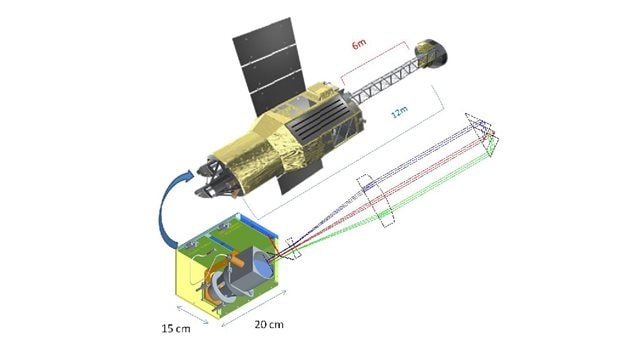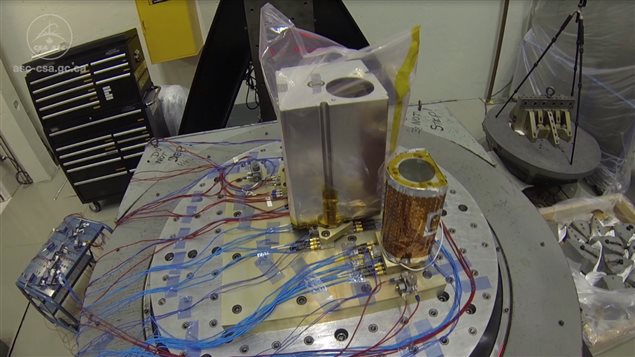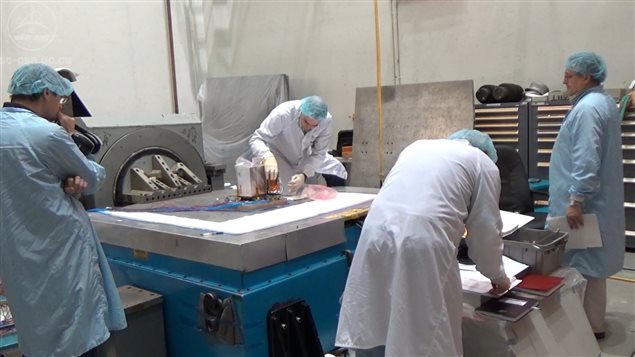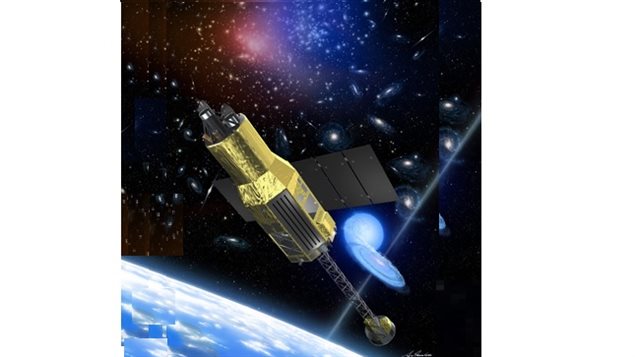That’s one of the aspects of a new Japanese-led international space project called Astro-H.
The new international probe uses five specialized x-rays and detectors to peer deep into monster black holes, and the traces of supernovae, gigantic explosions of stars of the past.
Canada is one of the contributors to the mission along with the US and Europe.
The Canadian Space Agency involvement is a contribution of a key instrument in conjunction with the Hard X-ray telescope. The telescope will sit at the end of six-metre mast, that will be flexing due to orbit vibrations and temperature shifts from -30 °C to +40 °C.
The Canadian instrument is called CAMS, Canadian Astro Metrology System, and its purpose is to measure mast flex to within the width of two human hairs allowing mission operators to calibrate the data of the Hard X-ray Telescope and significantly enhance the telescope’s performance.

ABOVE: Illustration of ASTRO-H Metrology System, or CAMSonboard ASTRO-H. CAMS consists of two laser units (each approx. 15 cm cube) mounted on the satellite and a corner cube optical reflector installed at the end of the space observatory’s 6 metre mast where the hard X-ray telescope sensors are located. The units fire laser onto the corner cube, which reflect the beam back into the unit where lateral displacements are measured down to a level of accuracy equivalent to the width of two human hairs. By comparing the measured lateral displacement on each sensor, the rotation about the telescope’s main axis can be determined and the data acquired at the time of observation can be calibrated to a much higher level of accuracy than in the absence of the Canadian measurement system.
As a result of Canada’s contribution, scientists from Canadian institutions will be on the mission’s Science Working Group. They will be offered observing time on the space observatory probe instruments. Data collected from the mission will be made available to all scientists/astronomers.
Canadians on the working group will be Dr. Luigi Gallo, Principal Investigator for ASTRO-H Metrology System, or CAMS, of Saint Mary’s University in Halifax Nova Scotia; Dr. Brian McNamara of the University of Waterloo, Ontario; and Dr. Samar Safi-Harb of the University of Manitoba

The mission will peer into distant black holes billions of times with mass billions of times that of our own sun.
By using unmatched spectral resolution, combined with the ability to focus high-energy X-rays, ASTRO-H will make the most precise measurements ever obtained of the chemical ingredients that go into making these colossal cosmic explosions, and will probe the sites of particle acceleration to the highest energies
Quoted on the Canadian Space Agency website, Astronomy Professor Gallo says “Canadian scientists get a chance to go to the front of the line in getting time to use this unique astronomical telescope. There is no doubt that we will be making big discoveries when it opens for business in three years’ time.”

From CSA website
Dr. Gallo will be making good use of his time on board ASTRO-H to study the ebb and flow in the X-raysbelched out by the supermassive black holes. These fluctuations in the amount of X-rays are thought to be directly correlated to the amount of material being gobbled up by the black hole: any nearby stars, gas and dust clouds get swept up from the plane of the surrounding inner region of the galaxy. As matter is sucked in by the gravitational pull of the black hole, it gets torn apart and superheated, shooting radiation back out in space, which ASTRO-H will detect.
Astronomers believe early on in a galaxy’s life, supermassive black holes sweep up most of the surrounding material in the galactic core. The black hole eventually quiets down as it runs out of cosmic things to eat; these voracious cosmic predators then calm down, allowing their host to become a normal galaxy (much like our own Milky Way).
ASTRO-H will be able to look at the very closest region around these giant black holes where the most intense X-ray radiations are being emitted. Not only will this give astronomers a clearer picture of how these cosmic predators evolve, but also how galaxies like our own came to be.
Dr. Samar Safi-Harb of the University of Manitoba will be investigating with ASTRO-H the high-energy phenomena associated with the supernova explosions of massive stars that form some of the most exotic compact objects in the Universe: neutron stars. These phenomena include particle acceleration of cosmic rays to extremely high energies, the formation of the heavy elements essential for life, and the physics of the extreme associated with neutron stars and their associated high-energy nebulae. Such studies will be enabled by ASTRO-H‘s combination of its broadband X-ray spectroscopic coverage, hard X-ray focusing capability, and the unprecedented spectral resolution offered by its X-ray micro-calorimeter.
Dr. Brian McNamara, Professor of Physics and Astronomy and University Research Chair in Astrophysics at the University of Waterloo, will use ASTRO-H to study powerful outbursts from massive black holes located at the centres of galaxy clusters. The energy released by matter falling onto supermassive black holes weighing more than one billion suns is equivalent to the mechanical energy of ten billion supernova explosions. This energy drives outflows of chemically enriched gas hundreds of thousands of light years into space. ASTRO-H will measure the mass and speed of the outflowing gas, allowing McNamara’s team to determine the rate at which supermassive black holes are growing. The measurements will also help unravel the nature of the mysterious extragalactic “radio jets,” which are streams of energetic particles flowing from the centres of galaxies at nearly the speed of light. ASTRO-H will advance our understanding of energetic feedback from supermassive black holes, an area in which Dr. McNamara is a recognized expert.
Additional information-sources
Live stream of Astro H launch website







For reasons beyond our control, and for an undetermined period of time, our comment section is now closed. However, our social networks remain open to your contributions.